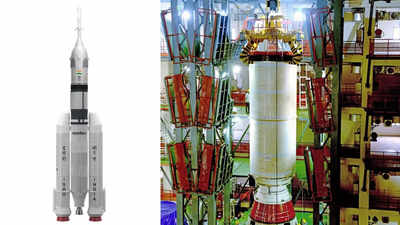- News
- City News
- bengaluru News
- Isro starts Gaganyaan uncrewed mission campaign exactly 10 years after CARE Re-entry Experiment
Trending
Isro starts Gaganyaan uncrewed mission campaign exactly 10 years after CARE Re-entry Experiment
Ten years after the Crew Module Atmospheric Re-entry Experiment (CARE), ISRO launched the G1 mission campaign for its first uncrewed Gaganyaan mission. The Human-rated Launch Vehicle (HRLV) is being prepared for launch early next year, marking a significant step towards India's human spaceflight ambitions.

Isro starts Gaganyaan uncrewed mission campaign
On Wednesday, at precisely 8.45 am at the Satish Dhawan Space Centre (SDSC), Isro initiated the launch campaign for the Human-rated Launch Vehicle or HRLV. The G1 mission, which was initially targeted for this month, is expected to happen early next year. Following this, ISRO will conduct two more uncrewed missions and a host of abort and test missions before attempting to send humans to space.
“The first step in the G1 campaign involved stacking the nozzle end segment of the S200 motor, signalling the start of a meticulously planned mission. The HRLV is a sophisticated three-stage vehicle standing 53 metres tall and weighing 640 tonnes, with a payload capacity of approximately 10 tonnes to Low Earth Orbit,” Isro said.
Derived from Isro's LVM-3 launch vehicle, the HRLV, unlike its predecessors, has been specifically designed with enhanced reliability and human safety considerations, including a comprehensive Crew Escape System (CES) operational from launchpad to atmospheric separation.

“Current preparations are progressing simultaneously across multiple Isro centres. While S200 motor segments are being assembled with their control systems and avionics, the L110 and C32 stages are already positioned at the launch complex. Crew escape system elements have been received, and critical module integrations are underway at the Vikram Sarabhai Space Centre (VSSC) and UR Rao Satellite Centre (URSC),” Isro said.
Given that the G1 campaign has begun exactly 10 years since the CARE mission, to launch which Isro used the LVM-3 rocket, the space agency, reflecting on the journey, said G1 draws direct inspiration from the 2014 mission. That experimental mission validated critical technologies essential for human spaceflight, including complex flight control algorithms, vehicle performance, and crew module re-entry mechanisms.

“The CARE mission, conducted on December 18, 2014, successfully demonstrated a full-scale Crew Module's ability to navigate through Earth’s atmosphere. By lifting a 3,775 kg Crew Module to a suborbital altitude of 126 km and executing a controlled re-entry and parachute-assisted splashdown, it provided crucial insights that have shaped India's current space exploration strategies,” Isro said.
Incidentally, current Isro Chairman S Somanath was the mission director for CARE, while VSSC Director S Unnikrishnan, who was also the founding director of ISRO’s Human Space Flight Centre (HSFC), was the payload director in 2014.
Stay updated with the latest news on Times of India. Don't miss daily games like Crossword, Sudoku, and Mini Crossword.

About the Author
Chethan KumarEnd of Article
FOLLOW US ON SOCIAL MEDIA






